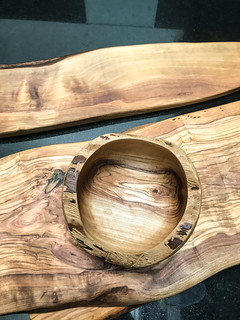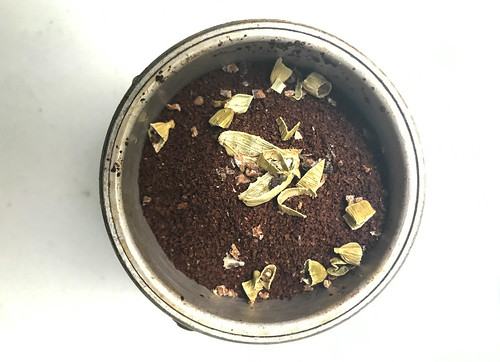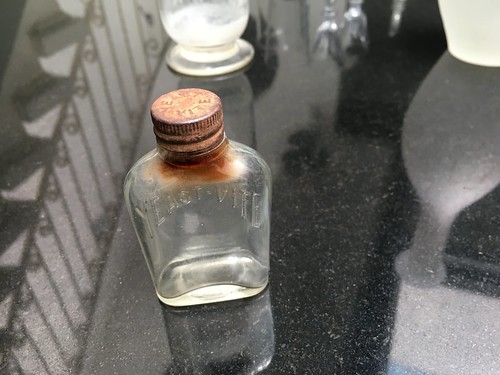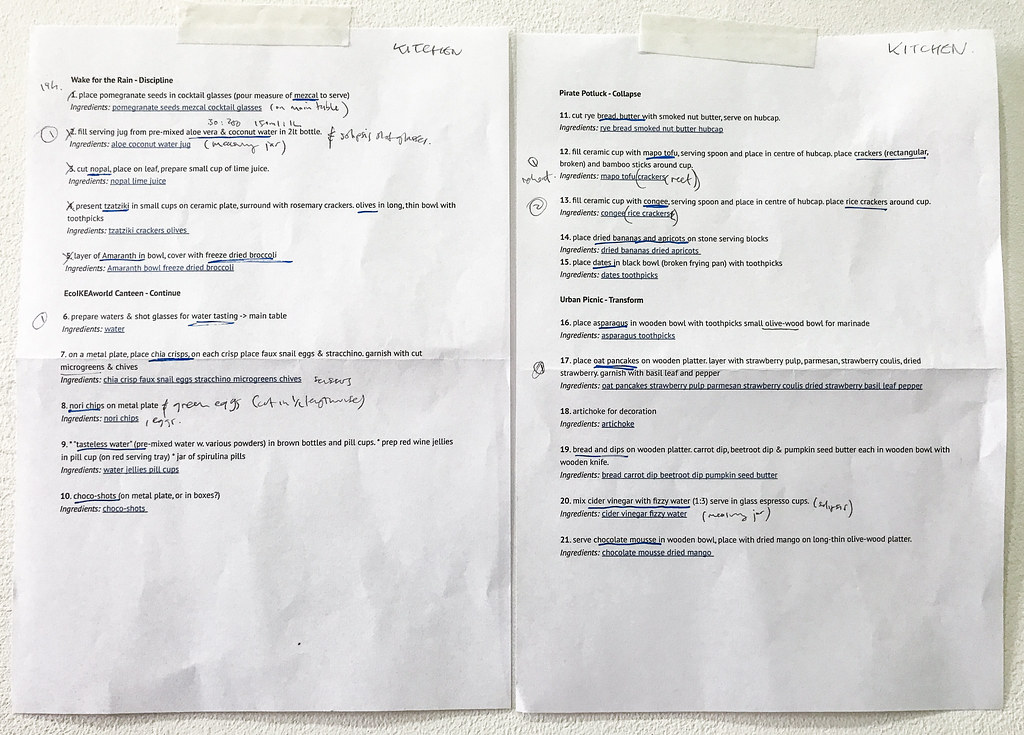Table of Contents
Tasting Tomorrow - prototyping
Based on the tasting tomorrow scenarios, developing tasting tomorrow recipes, toward a tasting tomorrow menu and artefacts for the Archived Futures Harvest exhibition.
Prototyping team: FoAM (Nik Gaffney & Maja Kuzmanovic), Greta Muscat Azzopardi, Natalie Debono, Letta Shtohryn and Tim Boykett.
With conceptual contributions from Kurt Micaleff, Johannes Buch

Urban Picnic
(in 5~10 years)
Bite-sized street-food. Ingredient-driven, hyper-seasonal, a blend between “high-brow” and “low-brow”. Imagine what a street “kaiseki” or barbecued “cuisine vegetal” would be like. The portions should be tiny, handheld for those on the move. Alternatively, a liquid dish can be slurped from a wooden bowl which guests carry with them at all times. Techniques can include both the traditional and innovative - anything goes, so long as it brings out the genuine deliciousness of the ingredients. Food is served either on communal platters, or in simple pots/bowls. If dishes are packaged, the packaging should be either compostable or reusable.
Tastes. fresh, savoury, fruity, juicy, seasonal, surprising (e.g. flavour pairing), can be extravagant but without complexity
Textures. moist, 'melt in the mouth', crispy, bubbly
Colours. colourful, intense, radiant, glazed
Temperature. warm, body temperature, room temperature, chilled accents
Ingredients. seasonal (daily changes), vegetables, fruits, grains, honey, sustainable proteins, (flat) wholemeal bread/crackers/crisps, mustard and other cruciferous vegetables, citrus fruits, slightly fermented drinks (kombucha, elderflower, young wine…), colourful dips…
Serving & presentation. hand held, sharing plates, (olive) wood bowls and boards, rough ceramics

To prototype
For exhibition:
- Signage to urban picnics
- Sketches for ziplining jumpsuit
- Wooden cup with attachment to jumpsuit
- Food archaeology samples (empty jars/bags, dry ingredients…)
For the menu:
- Barbecued (wild) green asparagus kebabs in soy-lemon marinade
- Strawberry, Maltese honey, basil and parmesan on oat pizzette
- Some pastizzi alternative?
- Fresh sourdough or flat bread with dips:
- Beetroot and hazelnut butter
- Carrot and rosemary puree with lemon zest
- Spinach mash with black tea and yuzu
- Elderflower champagne
- Popping sugar glazed with dark chocolate, chilli and olive oil

Wake for the Rain
(in 50~500 years)
Foods and drinks designed for a ritual - Wake for the Rain. Symbolic presentation of small dishes and drinks, possibly including a ritualised consumption process. Simplicity of dishes can be complemented by complexity of ways to eat/drink them. Concentrated, dehydrated or freeze-dried products. Saliva producing dishes, thirst quenching juices. Raw food or cooked sous vide to preserve moisture. Mezcal as the religious drink.
Tastes. subtle, bitter, citric, limpid, uncomplicated, dry, concentrated
Colours. translucent, (pale) green, white, red accents
Textures. contrast between liquid and moist vs dry and dehydrated, misty, ethereal
Temperature. cold, chilled, room temperature
Ingredients. aloe, agave, nopal cactus, olives, lime, pomegranate, goat-dairy (milk, yoghurt, cheese, meat), herbal distillates, essential oils, crystalised herbs, amaranth, freeze-dried green vegetables, cucumber, coconut water, mezcal, rhubarb, witlof (Belgian endives); NOTE: ingredients can be salty, but no salt should be added to them
Serving & presentation. measuring cups, metal, stone, tamarix africana (malt. bruka), spray bottles, clear, etched or milky glass.

To prototype
For the exhibition:
- Water preservation research documents
- Measuring cups
- Stillsuit sketch/photograph
- Architectural sketch for water-saving building
- Steam recycler sketch
- Water saving breathing exercises for children
- Bag of saliva producing pebbles
- Dr Bronner's soap (water can be reused after washing with this soap)
- Food archaeology samples (empty jars/bags, dry ingredients…)
For the menu:
- Wild Fennel infused mezcal with pomegranate seeds
- Aloe vera coconut water shots
- Lime-infused nopal chips in dehydrated olive crust
- Sage hydrolate with grapefruit juice
- Amaranth cracker with goat yoghurt tzatziki
- Freeze-dried broccoli chips

Pirate potluck
(50~500 years)
“Contribution soups”, porridges or other gooey and 'unrecognisable' semi-liquids. They can either be intensely flavoured themselves or taste rather bland and be served with multiple side-dishes (pickles, chutneys, sauces, dried fish/meat) to add flavour. They can be eaten on their own or with rough, heavy breads and crackers.
Tastes. Dry, smoky, salty, umami, fishy, pungent, fermented (funky), complex and intense
Colours. Rust, dust, browns and olive-green, mold
Textures. Gooey, crunchy, rough, rustic
Temperature. Hot, warm
Ingredients. Smoked/dried meat, fish and vegetables, insects, katsuboshi, seaweed, sea vegetables (samphire, purslane…), wild asparagus, wild herbs, wild fruit and veg, dates, coffee, 'exotic' spices, (natto) miso, tofu, harissa, funazushi, pickled fish and vegetables, fish sauce, sourdough bread, rye, rice
Serving & presentation. Car/ship parts (hubcaps, mirrors, lights…), discarded plastic, rough clay, steel, cardboard
To prototype
For the exhibition:
- Smuggled coffee samples, smugglers logbook and coastguard's spy-sheet: artefact for Archived Futures exhibition, designed by Letta Shtohryn
- Piracy hotspot map (centred on Malta)
- Rock soup (rock, pot, recipe, story)
- Scavanged car parts serving as dishes
- Food archaeology samples (empty jars/bags, dry ingredients…)

For the menu:
- Heart porridge (rye porridge with cured, smoked beef heart (aka. “Heart of unknown provenance”), served with garum)
- Pirate mapo (tofu mash with harissa and dried apricots)
- Fish-slime congee (rice porridge with dried fish (paste), natto miso and dulse flakes)
- Crackers - Rye sourdough, mixed seeds

EcoIkeaWorld canteen
(5~50 years)
Suggestions for culinary prototyping
Food as medicine, medicine as food. Superfoods. Data-driven diets.
Tastes. Clean, green, simple, vegetal, bland, unspiced, savoury, one dimensional, bright, neutral, metallic, square, round, slightly sweet
Colours. Leafy green, white, brown, grey, blood-red, blue.
Textures. Smooth, blended, encapsulated, slippery, viscous.
Temperature. Cold.
Ingredients. Matcha, green tea, spirulina, multigrain crackers, wheatgrass, avocado, berries, mackrel, snail eggs, microgreens, nori snacks, quail eggs. (special or scarce ingredients: red wine, chocolate, marmite)
Serving & presentation. Clinical, generic white crockery, square but rounded, without too many sharp edges; stainless steel cutlery, crystal water bottles (with charcoal filters), medical grade plastics and glass, barcodes; clean, tidy, no connection and no enjoyment;

To prototype
For the exhibition:
- EcoIkea citizenship application form
- Weekly powder intake box
- Pills and pill-boxes
- Marmite
- Yeast smuggling bottle
- Food archaeology samples (empty jars/bags, dry ingredients…)

For the menu:
- Water tasting
- Snails in the garden (microgreens with faux snail eggs on a chia seed crisp)
- Clandestine elixir (marmite soup with spirulina, seeds and grains in pill cups)
- Nori chips with green tea quail eggs
- Raw super-juice (tasteless water + spirulina served with an extensive printed list of nutritional info)
- Supergreen capsules
- Matcha soy latte
- Choco-shots (broad spectrum antidepressant and coconut 'botox')
- Red wine gummy bears / jelly babies (reservatol)

Dishes and serving

Including artisanal dishes from local artists and crafters Sue Mifsud, Paul Singleton, The Olivewood Shop.
(in progress as of 20170504)
- Mezcal (infused with wild fennel) with pomegranate seeds - flea market chalice + SS cocktail glasses
- Aloe vera coconut water - Phoenician glass pitcher SS shot glasses
- Tzatziki, dried olives, rosemary crackers - Sue Mifsud ceramic plate with small ceramic cups
- Freeze-dried broccoli chips on a bed of popped amaranth - Sue Mifsud metallic ceramic plate
- Nopal with lime - spiky nopal leaf (from Bahrija)
- Water tasting - shot glasses (JB)
- Snails in the garden (microgreens with faux snail eggs on a chia seed crisp) - on flea market metal plate
- Nori chips with green tea quail eggs - on flea market metal plate
- Weed juice (supergreens infusion served with an extensive printed list of nutritional info) in pill cups
- Red wine jellies (reservatol) - in pill cups (from pharmacy)
- Choco-shots (broad spectrum antidepressant and coconut 'botox') - syringes, boxes
- Rye bread with smoked nut butter (almonds, hazelnuts, pine nuts) - Flea market hubcap + S. Mifsud ceramic bowl
- Pirate mapo (tofu, harissa, olives and dried apricots), rough seedy crackers - hubcap+stand+rough ceramic bowl
- Fish-slime congee (rice porridge with seaweed) with rice and quinoa crackers - hubcap+stand+rough ceramic bowl
- Dried black bananas and apricots - served on stones (from artisan in Ta'Qali)
- Dates in coffee and cardamom, carob (Leila) - in broken frypan
- (uncooked globe artichokes for presentation)
- Barbecued green asparagus kebabs in soy-lemon marinade - in Paul Singelton's wooden bowl with bamboo toothpicks
- Strawberry, Maltese honey, basil and parmesan on oat pancakes - Paul Singelton's wooden platter
- Fresh sourdough or flat bread with dips - Paul Singelton's wooden platter
- Beetroot and roasted hazelnut/pine nut butter - small bowl from The Olive Wood Shop
- Carrot and rosemary and tarragon puree with lemon zest - wooden bowl from The Olive Wood Shop
- Pumpkin seed butter - wooden bowl from The Olive Wood Shop
- Cider vinegar / Elderflower champagne - glass teacups from SS
- Dark chocolate mousse with ginger and olive oil) with dried mango - wooden bowl from The Olive Wood Shop, Paul Singleton wooden platter - eat with mango rather than spoons

Notes (in progress) → http://subetha.fo.am/p/tasting_tomorrow_menu